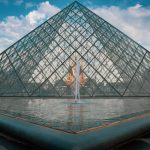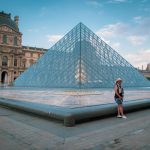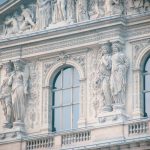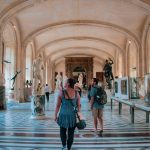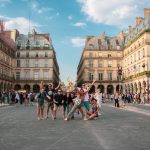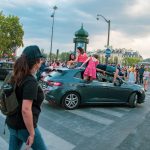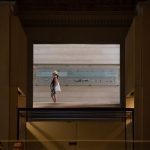By Anianikū Chong, UG Student in Art & Hawaiian Studies
On the morning of July 16th we set out early to visit the Louvre Museum. The Louvre was originally built as a fortified enclosure in 1190 and used as a display of King Philippe Auguste authority as he was preparing to leave the country to go to war in the Crusades. It was later reconstructed in the 16th century to serve as a royal palace. Like many of the others buildings in Paris, in was a place that was constantly being built and rebuilt, expanding with each monarch covering a total area of 652,300 square feet today. In August of 1793 the National Assembly opened the Louvre as a museum with a collection of 537 paintings. Today, the Louvre Museum is recognized as the world’s largest museum that houses one of the most extensive art collections. Some of these collections include Egyptian antiques, ancient Greek and Roman sculptures and Arts of Africa, Asia, Oceania and Americas with work that spans from the sixth century B.C. to the 19th century A.D.
Aside from the fact that it is a major tourist attraction bringing in nearly 8.1 million people in 2017, it was also one of the places that both Alexander Liholiho (KIV) and Lot Kapuaiwa (KV) visited during their time in Paris in 1850. Prior to arriving at the Louvre, we read through Liholiho’s journal entries dating back to he and his brothers first visit on February 12, 1850 that describes their initial impressions. Liholiho writes, “The whole salon was about a quarter of mile long. Different paintings by the first artists in Europe, and some very well executed…When we had got to the further end of the Gallery, we could hardly see the door by which we entered.”
Similar to Liholihoʻs experience upon entering the Louvre, the mere size of the rooms and amount of art and paintings inside was overwhelming. Never could we have imagined a single place that could house so many pieces of art that came from all over the world. Among the many different pieces and collections of art that were at the Louvre, many of us were most anxious to see what pieces of art we would find in the Arts of Africa, Asia, Oceania and Americas Collection. We were a bit disappointed to see that there was just a single kiʻi on display at the Louvre from Hawaiʻi yet we were also relieved to know there weren’t much artifacts from home.
Interestingly enough, Liholiho notes during his visit in 1850 that, “There was nothing that I could see that was brought from home, except some Tapa and fish nets.” It begs the question as to, where those tapa and fish nets came from? How did the museum acquire those pieces? Where are they now? Walking through room by room, collection to collection, it was easy to be in awe of all of its beauty. But with each room and each hour that went by, a weight of emotions slowly came over some of us. It was the realization of the amount of time, energy, money and possibly force that was spent to extract these historical artifacts from different places and cultures to be brought here. One example of this instance was the Egyptian Antiquities collection and seeing boulder size engravings, statues and even an actual mummy. Liholiho notes his experience through this same collection as being “ filled with most ancient curiosities…such as mummies of men, women, children, dogs, cats, crocodiles, fishes, egyptian gods.” For us, seeing iwi out on display as such was a really uncomfortable feeling. It make us wonder what our aliʻi really thought about this same sort of display of iwi during their time.
After the Louvre visit, some of us stayed in Paris to watch the final match of the World Cup (France v. Croatia). It was an incredible experience to be with all of the Parisians watching and then celebrating in the streets. There were literally hundreds of thousands of people that filled the streets, prompting metro closures and our walking back approximately 6 miles to our university housing. Our group thought that the experience really exemplified a sense of lāhui, solidarity, and nationhood that was refreshing and special to witness in this program.
Photo Credits: Anianikū Chong




